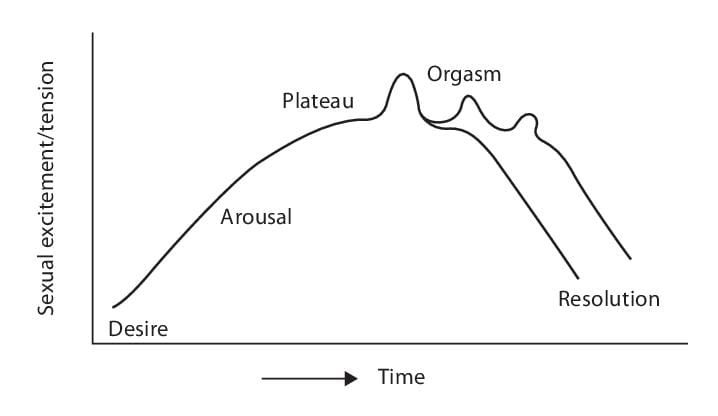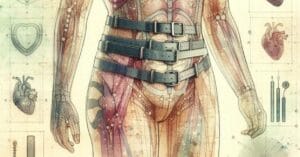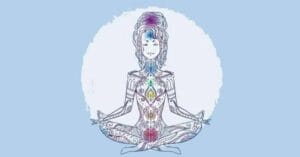From Olga, co-author of the online course:
I’m writing here exclusively about my own experience and explorations on my body. These explorations stemmed from the experiences shared by others, which I tested on myself, leading me to derive this technique for transitioning from one type of orgasm to another.
There’s a prevalent belief nowadays, widely discussed, that all orgasms are clitoral and only occur under tension. It’s thought that as we approach it, it’s tension, and after reaching the climax, relaxation follows.
For a long time, I experienced only clitoral orgasms (both internal and external) from stimulating the clitoris or G-spot (the orgasm felt as clitoral). This coincided with increased arousal and increased tension in my pelvic floor muscles.
As I understand it now, this is what happens:
By tensing specific parts of the body, we retain and concentrate the energy of arousal in the genital area, resulting in a faster but localized orgasm.
Therefore, the technique and habit of tensing muscles during orgasm are effective if the goal is a quicker climax. If achieving orgasm is difficult, this tension is necessary.
The subsequent experience I had involved A-spot orgasms, cervical orgasms, various non-clitoral orgasms. All these orgasms occur through relaxation, unrelated to tension. If tension occurs (during strong arousal), it only hampers these relaxed orgasms. They are better experienced when completely relaxed. When the mechanism of tensing muscles activates during intense arousal, it disrupts achieving these other relaxed orgasms.
For a long time, I believed that some orgasms could be relaxed while others required tension (specifically referring to clitoral orgasms here).
Then I experimented on myself. By trying it out, I understood that a clitoral orgasm can also occur through relaxation. And it brings about completely different sensations.
This technique could serve as a transition to understanding how other non-clitoral orgasms (A-spot, P-spot, PS-spot, and others) occur in the body.
Here’s what I did: I stimulated the clitoris, and as I approached orgasm, tension arose, and my muscles began to tighten. I observed this process, and just before the orgasm, I consciously relaxed the muscles with an exhale (made a deliberate effort to relax), while continuing the stimulation.
The orgasm didn’t happen at that moment. If I had held the tension, the orgasm would have occurred. But as I relaxed, the arousal decreased as it spread throughout the body. It wasn’t as intense, but it was felt over a larger area of the body. A wave of warmth passed through the entire body.
It's crucial to breathe deeply and slowly at this moment. Breathing helps distribute the energy throughout the body.

I continued stimulation at the same pace and rhythm to a new “plateau” stage several times. And when the muscles, preparing for orgasm, contracted, I deliberately relaxed them.
Eventually, by training this way and accumulating arousal throughout the body, which almost reached its peak each time, there was so much arousal that, in one of these attempts, even when I relaxed my muscles, the orgasm still occurred.
And this is an orgasm on the relaxation. It started in the genitals, was as intense as the tension-induced one, but it spread throughout the body.
I believe this technique would work well for those who want to experience whole-body orgasms.
If this technique doesn’t work, for example, it’s hard to sustain arousal for long or without muscle tension, there’s a practice to increase arousal in the body. I previously used it to intensify orgasms. I stimulated the clitoris along with the usual muscle tension, and when approaching orgasm, I stopped as soon as the arousal subsided slightly (3-5 seconds), then resumed.
I didn’t relax the muscles and continue stimulation; instead, I maximally tensed and stopped the stimulation at the peak. This way, the body also learns to prolong the plateau stage and accumulate arousal energy.
After achieving this orgasm on relaxation naturally, it becomes easier to move on to experiencing orgasms in other spots because it’s challenging to understand their technique without this.
I took a different path to non-clitoral orgasms (through extended yoni massage). Understanding how this should happen was very challenging for me. As arousal increased, I started tensing out of habit, and arousal, for instance, from the A-spot, shifted to the clitoris, and everything disappeared because it’s entirely different in its typology and way of achieving it.
If initially, a relaxed orgasm isn’t happening, it means one simply needs to practice and increase the number of “arousal-stop” cycles.
The more times we stop ourselves at the plateau stage and continue, the more arousal accumulates in the body. Its critical mass builds up and seeks an exit through an orgasm in any way possible.
Other details of the massage are described in the online course about yoni massage.





